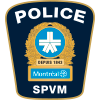
Human trafficking for the purpose of sexual exploitation
Human trafficking for the purpose of sexual exploitation is a crime that is often described as a modern form of slavery. Contrary to popular belief, most victims of this form of trafficking are young Canadian girls, not foreigners.
Human trafficking for the purpose of sexual exploitation and pimping are crimes that become interconnected when a person is forced into prostitution. In every case, the potential for violence and the means of controlling the victim can vary: threat of physical violence against the person and her/his friends, psychological violence, physical constraints, incitement to drug abuse, etc.
For various reasons, it is difficult to quantify the full extent of the problem of human trafficking for the purpose of sexual exploitation. Many cases are not detected, but more and more people are becoming increasingly aware.
The research
A recent study by the SPVM shows that a small proportion of pimps was responsible for a large share of sexual assaults against women, and that more than half of these assaults were recorded as domestic violence.
The study also reveals that women who are part of the immediate environment of offenders who are close to gangs are at significantly greater risk of being physically assaulted.
A second study reveals that people suspected of pimping and their accomplices are much older than their victims. None of the victims belonged to a street gang, whereas the majority of suspects did, and had run afoul of the law. For most of the victims, the exploitation began following a romantic relationship with the pimp.
The study also shows that the victims are constantly moved from city to city to work in bars and as dancers. In addition, most of them hand all of their earnings over to their pimp. They are generally controlled through physical or psychological violence. In most cases, the victims went to a police station to report the exploitation to which they were being subjected.
The two studies’ findings highlight the important of violence in human trafficking for the purpose of sexual exploitation, and the connections with gangs. The results were affected by the mobility of the victims and the operators.
SPVM researchs
Août 2009
Revue de littérature sur les meilleures pratiques quant à la prostitution de rue
Lecture de l'environnement 2013
4.3 La traite de personnes aux fins d’exploitation sexuelle et la prostitution
Lecture de l'environnement 2013
4.4 Les proxénètes violents et leurs victimes
Revue de littérature - Juin 2014
Prostitution et traite de personnes à des fins d’exploitation sexuelle : prévention, protection, poursuite et partenariat
Revue de littérature - Juin 2014
Exploitation sexuelle et sujets connexes
Rapport de recherche - Mars 2015
La collaboration des victimes d’exploitation sexuelle auprès des enquêteurs
Des ob stacles et des facilitateurs
Rapport corporatif - Mars 2015
Le proxénétisme au féminin : étude sur le rôle des femmes dans le recrutement de prostituées à Montréal
Rapport de recherche - Avril 2015
L’identification de victimes d’exploitation sexuelle à travers les données officielles
Rapport de recherche - Mai 2015
Diagnostic local sur la prostitution dans Hochelaga-Maisonneuve
Rapport final - Octobre 2015
Diagnostic sur la prostitution et l’exploitation sexuelle dans Ahuntsic
Statistics
In Canada, between 2007 and June 2013, there were 146 cases in which charges of human trafficking were laid. Of these 146 cases, 137 were considered domestic trafficking for the purpose of sexual exploitation, and the other 9 were cases of international trafficking involving forced labour. While there may not be many cases, domestic trafficking appears to be more frequently detected by police than international trafficking.
In Quebec, between 2005 and 2009, 8 cases involving charges of human trafficking were reported. Between 2009 and June 2013, there were 31 charges of human trafficking in Montréal alone. This increase indicates more awareness of the phenomenon in and around Montréal, as well as progress in terms of the laying of charges involving human trafficking for the purpose of sexual exploitation.
What can you do?
If you become aware that a person is a victim of human trafficking, do not hesitate to denounce the fact to your neighbourhood police, or to report it anonymously and confidentially to Info-crimes Montréal.
If you are a victim of human trafficking, do not hesitate to ask for help from the police, or from school, community or health care personnel.
Complementary information
Although the problem extends beyond city limits, it is concentrated in urban centres, which have the most establishments dealing with sexual services.
The extent of human trafficking for the purpose of sexual exploitation has been denounced by several organizations, and common issues have been noted: it is difficult to pin down the number of victims because of the clandestine nature of the activities, and because victims are hesitant to contact the authorities.



